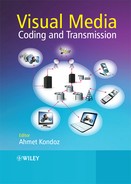2.2 Redundancy in Video Signals
Compression techniques are generally based upon removal of redundancy in the original signal. In video signals, the redundancy can be classified as spatial, temporal, or source-coding. Most standard video codecs attempt to remove these types of redundancy, taking into account certain properties of the human visual system.
Spatial redundancy is present in areas of images or video frames where pixel values vary by small amounts. In the image shown in Figure 2.1, spatial redundancy is present in parts of the background, and in skin areas such as the shoulder.
Temporal redundancy is present in video signals when there is significant similarity between successive video frames. Figure 2.2 shows two successive frames from a video sequence. It is clear that the difference between the two frames is small, indicating that it would be inefficient to simply compress a video signal as a series of images.
Figure 2.1 Spatial redundancy is present in areas of an image or video frame where the pixel values are very similar
Source-coding redundancy is present if the symbols produced by the video codec are inefficiently mapped to a binary bitstream. Typically, entropy coding techniques are used to exploit the statistics of the output video data, where some symbols occur with greater probability than others.

